
|
External Flash Units For Olympus C-5050Z, C-5060WZ, and C-7070WZ |

| My other pages related to the Olympus C-5050Z, C-5060WZ, and X-7070WZ |
|
This article is applicable to the C-5050Z, C-5060WZ, and C-7070WZ. Any differences, if present, will be explicitly stated in the text. The more recenf FL-36 flash is described in a separate article. Why an external flash? Let's face it: the flash built into the camera is only fit for emergencies — and barely so. (This is true about all built-in flashes, not just the one in the C-5050Z. Besides that, they may be useful to fill harsh shadows in bright outdoors, but not as the main source of illumination.) Therefore, if you need to take flash pictures indoors more than only occasionally, an external flash is a must. Out of a number of options available for the C-series cameras, I have checked out four, and here are some details. The full specs of all four units are in the table following general descriptions. |
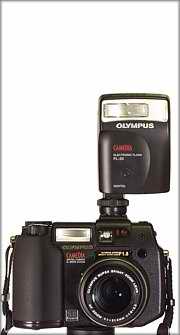
|
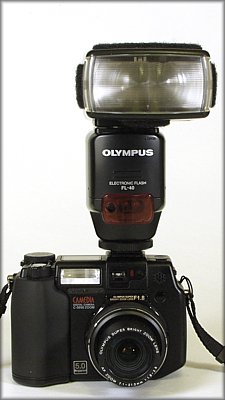
|
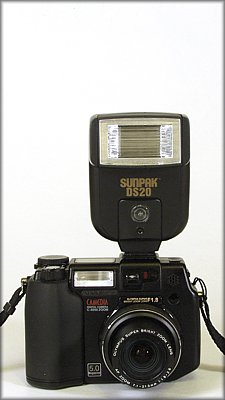
|
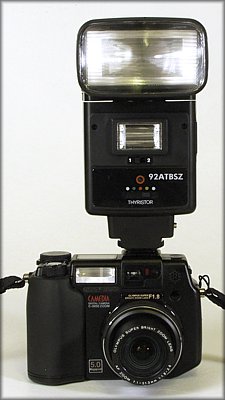
| |
| Olympus FL-20 dedicated TTL flash | Olympus FL-40 dedicated TTL flash | Sunpak DS20 automatic thyristor flash with a slave | Adorama 92ATBSZ automatic thyristor flash |
|
The pictures above allow you to compare the relative sizes of all these flash units, mounted on the C-5050Z. (Note the Velcro strips I'm using to secure the LumiQuest diffuser to the FL-40.) The Guide Numbers Perhaps the most important specification of a flash unit is its guide number (GN). For a given ISO rating, this is the product of the lens aperture number and the distance from which the flash still provides enough light for shooting at that aperture. For example, a GN of 20 m at ISO 100 means that, at that ISO setting, the flash provides sufficient light for shooting at F/2 at up to 10 meters, or at F/4 at up to 5 meters, at F/8 at up t 2.5 meters, etc. Note: in the U.S. it is customary to express the GN in feet. The GN of 20 m is the same as GN of 66 ft. With every doubling of the ISO setting, the GN increases by a factor of 1.41x (square root of 2). This means, for example, that the flash discussed above will have a GN of 40 m at ISO 400 (1.41*1.41 is 2). When comparing flash units keep in mind that doubling the guide number means quadrupling the light output. Therefore the smallest external flash by Olympus, FL-20, at GN=20, provides four times the punch of the flash built into the C-5050Z camera (GN=10). |
| Model | Internal (C-5050Z) | FL-20 | FL-40 | DS20 | 92ATBSZ | Notes |
|---|---|---|---|---|---|---|
| GN (m) @ISO100 | 10 | 20 | 26 (40) | 18 | 20 (40) | [1,4,5] |
| Automation | TTL | TTL | TTL | Ext. sensor | Ext. sensor | |
| F# @ISO100 | Any | Any | Any | 4.0 | 4.0, 5.6, 8.0 | |
| Tilt | No | No | Yes | Yes | Yes | |
| Swivel | No | No | Yes | No | Yes | |
| Zoom | None | None | Motorized | None | Manual | |
| EFL coverage | 35 mm | 35(24) mm | 35(28) mm | 35 mm | 28 mm | [6] |
| Burners | 1 | 1 | 1 | 1 | 2 | |
| Slave | N/A | No | No | Yes | No | |
| Sync voltage | N/A | 4.4 | 4.7 | 6.3 | 5.0 | [2] |
| AA Batteries | Camera | 2 | 4 | 2 | 4 | |
| Weight [g] | N/A | 75 | 350 | 100 | 300 | [3] |
|
Notes:
At $300 or so this fully-automatic, TTL-metering, dedicated model is, to put it mildly, overpriced, but it is powerful, has tilt and bounce capabilities, and smoothly integrates itself with the camera's exposure automation. It also provides pleasing results. I'm also using the FL-40 with an E-10 and E-20, and I like it a lot. As expected at this price, the unit is nicely built and finished; the only thing I don't like too much is the design of the battery compartment. When the flash is used with the C-5050Z (or C-4040Z, E-10/E-20) all its features accessible from the back panel are just disabled: the camera takes over completely. This is a feature, not a sign of incompatibility. In spite of its size and heft, the FL-40 sits nicely in the C-5050Z's hot shoe, and it works exactly as advertised, providing well-exposed pictures. For example shots with this flash, see my C-5050Z sample page. According to the '5050 manual, when the FL-40 is connected to the camera and both are turned on, it should find itself in the "Auto TTL" mode. Surprisingly, the flash control panel still shows just "Auto". In the beginning I was quite concerned with this, and then I noticed that when you half-press the shutter release (so that the exposure is being metered), the panel shows "TTL Auto"! This was quite difficult to spot, as usually I press the shutter release with my eye at the viewfinder, and not looking at the flash control panel. More, the flash also switches to TTL Auto as soon as you turn the image monitor on (it goes back to "Auto" as soon as the monitor is off). This behavior, although quite harmless, is quite confusing. On the E-10 and E-20 the "TTL Auto" goes on as soon as I mount the flash, and this clearly is how things should be. The "Reference Manual" mentions the half-press "feature", just glancing over it, and then stating that during the communication between the flash and the camera, the LCD monitor goes on. Regarding the latter, exactly the opposite is true: the communication is established when the monitor is turned on (neither option is too smart). I'm not the only one initially confused by this behavior: for the last few months I'm getting email complaints on this subject every week or two. And yes, the new FL-20 (see below) has the same problem. There is one more minor problem with the co-operation between the FL-40 and the C-5050Z. Set the camera zoom to wide angle, then press the zoom button on the flash to move the head to the Tele position. It will stay there regardless of the current camera zoom setting even when you press the shutter release — your pictures will show significant light fall-off toward the edges. Ugly. As soon as the zoom lever is activated, however, the flash catches up. The flash zoom feature is also almost useless on the '5050. First, the head has only two extreme zoom positions; secondly, it stays in the "wide" setting almost all the time, moving to "tele" only just before the camera lens reaches the longest focal length (at EFL about 100 mm). As a matter of fact, on the E-20 the switch occurs at the equivalent focal length of about 80 mm. Strange. Oh, well, enough bitching; this is still a great flash, and I'm very happy with its performance and smooth integration with the C-5050Z, E-10, and E-20. As of late 2003 the FL-40 is being replaced with the newer FL-50 (priced even higher than its predecessor). I haven't used the newer model, but it is generally very close to the FL-40. Its only radically new feature is the "multi-burst" flash, effectively spreading the light over a longer period of time (actually, emitting a series of densely-spaced bursts). This feature is useful with focal-plane shutters only, and it was introduced specifically for the new E-1. It is not applicable to the C-series cameras. Therefore if you want a powerful, fully integrated flash for your C-5050Z or C-5060WZ, go for the older unit, as it will be less expensive. |
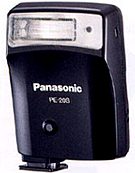
|
One of the Readers has reported that the FL-20 is an almost exact clone of the Panasonic PE-20S flash from a few years ago. Both models look almost identical, except that the Olympus one is dedicated (read: different embedded software and extra contact pins). Most probably Olympus farmed out the production of their flash to Panasonic, which makes a business sense. The PE-20S seems to be available only in Japan and the Far East, and the price is close to $80-$90. |
|
You may be unwilling to spend $300 on the FL40, or maybe you prefer a smaller flash for this camera. This automatic, thyristor unit works just fine with the '5050. The DS20 works either set in auto mode (being triggered via the camera's hot shoe and metering its own light), or as a slave auto (same, but triggered by the built-in flash, no electrical connection). The camera should be set to manual in both cases. The automatic system in the DS20 works with just one aperture value; for ISO 100 it is F/4.0, while for ISO 64 — F/3.2. (Actually, I was getting slightly better results with the lens closed down by 1/3 or 2/3 of a step.) The flash has a bounce head, especially usable in the slave mode (even in the hot shoe), when the built-in unit provides not only the triggering light, but also a fill, adjustable from the camera in ten steps). Just be careful, the bounced light is barely adequate! Laws of physics. In spite of the rock-bottom price, the unit seems to be quite well-built and finished. The two complaints I may have are limited power (OK for direct light, but barely, if at all, suitable for bounce lighting), and the single aperture setting. Adding F/2.8 would be very nice. The auto confirmation light in the DS20 does not work at all. Strange. I had this confirmed by another user. The DS20's major advantages are the small size and weight; it is not as pocketable like the FL-20, but still. I bought it at Ritz Camera for $30. If you need a reliable bounce capability, the Sunpak model is not strong enough for your needs. If you don't mind a really big thing sitting on the top of your camera, this house-brand model from Adorama is an inexpensive alternative. It has both bounce and swivel capability, and, even better, a switchable, separate fill-in burner below the main one. The unit's thyristor-based automation can be set to work with three aperture values (F/4, 5.6, and 8 at ISO 100). The head has four zooming positions, starting with a claimed coverage for a 28mm (equivalent) lens. Although the exposure automation seems to work right in the direct light mode, I found my bounced-flash pictures taken with the Adorama unit underexposed. This, obviously, was not because of insufficient power available: switching the flash to the F/8 setting while keeping the camera at F/4 rectified the situation. About twenty years ago I bought a very similar flash by Hanimex, no longer to be found; in addition to some cosmetic alterations, the only difference is that the old unit also had the slave mode, which the Adorama model does not have. The build quality is not so great; look and feel do not match those of the other flashes I'm talking about: you can see it's a cheap unit, but it is not too shabby either, just adequate. The flash is sold by Adorama at $50 (listed as "Adorlight Twin Blitz Bounce & Zoom Flash" at their catalog page), while the instruction sheet refers to it as Ultiblitz; some other vendors may be offering it under different names (the model designation in the instructions was on a sticker, covering another, referring to "2820 Twin"; a quick Web search brought me to the same unit sold in Italy as Jupiter 2820 Twin at about €50). A quick comparison Here is a comparison of the uniformity of illumination provided by the four flash units, as well as by the built-in flash. ALthough the FL-40 seems to have a slight advantage, I wouldn't really be unhappy with the others, either. This is the worst-case scenario, with the camera's zoom at EFL (equivalent focal length) of 35 mm; at longer settings the coverage will be more uniform. |

|

|

| |
| The built-in flash | Olympus FL-20 | Olympus FL-40 | |
|
All shots were taken from about 1.5 m, zoom at EFL=35mm, manual mode at or near F/4 and 1/200s. The exposure adjusted by trial and error to obtain similar brightness in the bright spot near (or just above) the center. Surprisingly, the uniformity provided by the internal flash seems to be second only to the FL-40! |

|

| |
| Sunpak DS20 | Adorama 92ATBSZ | ||
|
Now let us have a look at the exposure automation (light metering). For this I've shot a bookshelf, first from a distance of about 1 (3ft+), and then from 4 m (13ft). With the external flashes, the internal one was disabled. All pictures were shot at ISO 100 and F/4; for the Olympus TTL flashes aperture priority was used, for the others the camera was set to manual. No exposure of flash compensation was used. First, the close-distance pictures. All flashes are supposed to handle light metering from this distance, so I would expect acceptable exposures (still, in the past, every flash I've used had its own correction factor, usually within 0.5 EV). The zoom was at the wide end. | |||

|

|

| |
| Internal flash, 1 m | Olympus FL-20, 1 m | Olympus FL-40, 1 m | |
|
All flash exposures are acceptable here, within 0.5EV or so from each other. From full-size images I liked the FL-40 best, maybe because the softest light (largest burner?), or because it used the lowest exposure. Anyway, the differences do not matter, and for casual shooting with the built-in flash I'm using a -0.3 EV compensation anyway. |

|

| |
| Sunpak DS20, 1 m | Adorama 92ATBSZ, 1 m | ||
|
For the four-meter distance shots, I have set the zoom to the long end (EFL=105mm), trusting that the effective aperture value at the same aperture setting does not depend on the focal length (outdoors pictures with spot metering seem to confirm this). For the internal flash I had to use the aperture of F/2.8 here, as at F/4, 4 meters would require a GN of 16. | |||

|

|

| |
| Internal flash, 4 m | Olympus FL-20, 4 m | Olympus FL-40, 4 m | |
|
The results from Olympus units are consistent with those at one-meter distance. The built-in flash exposes slightly stronger in both cases (I've checked this also in the full auto mode). Both third-party flashes underexpose at this distance; the TTL metering seems to have a slight edge. (Maybe the manually set aperture is smaller than the camera indicates at this focal length? This looks like one full F-stop.) |

|

| |
| Sunpak DS20, 4 m | Adorama 92ATBSZ, 2 m | ||
|
For a quite significant improvement in the quality of light provided by the FL-40 (or by the Adorama flash), you may consider spending another $35 for the LumiQuest ProMax flash diffuser. It may look overwhelming on the tiny camera, but does its job just fine. Flash use with lens attachments The auxiliary lens attachments for the C-5050Z (or most other digital cameras) do not change the effective lens aperture, so that even without TTL metering (which is safe in either case) no special exposure compensation is necessary. On the other hand, they block some of the light coming from the built-in camera flash, casting a strongly visible shadow within the lens field of view. This makes the built-in flash useless when working with the add-on lenses. Using an external, a hot-shoe-mounted flash alleviates the problem. Even the smallest of the flashes discussed here, the FL-20, provides enough extra distance between the burner and the lens axis to avoid any shadows. Here is the proof. These pictures of a wall were taken at the distance of about 1.5 m with the WCON-07, and from 2.5 m with the TCON-17. At the left you can see the results with the built-in flash; at the right — with the FL-20. |

|

|

| |
| WCON-07 (EFL=24 mm), internal flash | WCON-07 (EFL=24 mm), FL-20 | WCON-07 (EFL=24 mm), FL-20+diffuser | |
|
The FL-20 by itself does not have enough coverage for the WCON-07. This is why I'm including two samples for this lens/flash combination: one without, and one with the included wide-angle flash diffuser. Note that in this comparison I did not particularly care about providing the same exposure for all samples; all I want to show here is the lens shadow effect. |

|

| |
| TCON-17 (EFL=180 mm), internal flash | TCON-17 (EFL=180 mm), FL-20 | ||
|
It is quite clear: forget of using the built-in flash with any attachment lenses. An external flash, whether hot-shoe or handle-mounted, is a must here. Actually, even the Tiffen lens adapter with a UV filter casts some shadow in the image, as shown in this example. In most situations the shadow in the bottom-left corner can be lived with, but if you mind, take your lens tubes off when using the internal flash — or just get used to the external one used all the time. It provides better light and less chance for red eye anyway. |

|
|
UV filter on the Tiffen lens adapter, EFL=35mm, internal flash |
|
Basically, any third-party flash having thyristor-controlled automation should work just fine with the C-5050Z. I would still recommend making sure that the synch voltage is below 8V or so (in spite of Olympus' assurance that the '5050 has a high-voltage protection). With these flashes, however, the camera would have to be set to manual exposure, and the flash intensity is then metered and adjusted by the flash unit itself. Some manufacturers offer models with foot adapters, supposed to work with the camera's exposure automation circuitry, and more tightly integrated with the system. If you come across such a model, make sure that it has an adapter designed specifically for Olympus Camedia (as opposed to just Olympus, which refers to film cameras). Be also warned that such units may provide just some of the functionality of a dedicated system, not the whole range. | |
|
Metz, one of the most respectable flash makers, has a whole line of flashes which will work with Olympus Camedia cameras by means of a dedicated SCA 3202 adapter. The line includes 44 MZ-2, 45 CL-4, 50 MZ-5, 54 MZ-3 and 4, 60 CT-4, 70 MZ-4, and 70 MZ-5. One user reported that his Metz 32 MZ-3 flash works fine with the C-5050Z when used with the SCA 3202-M2 adapter for Olympus Camedia cameras. (Metz lists the E-10, E-20, and C-4000Z, but not the C-5050Z; the list seems outdated.) [Information courtesy of Brad Herman.] |
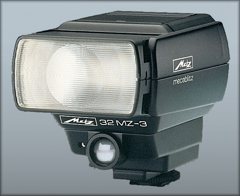
|
|
The MZ-3, when switched to the TTL mode, sets these cameras to the aperture priority exposure mode. It will not work in the program mode, but this is not a disadvantage: the advanced users (those who buy external flash units) prefer to work in aperture priority, having more control over the camera. From a recent Web research, I'm getting an impression that the 32 MZ-3 may have been discontinued. It used to be one of the best flashes available around, but Metz no longer lists it in the available literature. | |
|
I also received a report of the Metz 54 MZ3 working OK with the '5050 (using the 3202 SCA adapter). I am sure it will work equally well with the new model, too. The only (very minor) glitch is that the flash displays a slightly higher ISO setting than the one actually used by the camera, but this does not affect the exposure, as it is determined by the camera anyway. Even flash head zooming along with the lens works OK, better than in Olympus flashes. The Web site of Bogen, the U.S. distributor of Metz flashes, provides only rudimentary information on Metz units, and does not even mention the Camedia module. The German Metz site (recently reorganized and improved) fares a little better: you can actually check a table showing which features does a flash-adapter-camera combination supports. There are two Promaster units providing dedicated flash capability for Olympus digital cameras: 5750 DX and 5550 DX. I was able to check the former out (with positive results); for more details look here. Notable Web resources
| |

| My other pages related to the Olympus C-5050Z, C-5060WZ, and X-7070WZ |
|
Copyright © 2002-2004 by J. Andrzej Wrotniak.
Reprints and links permitted with proper credits. |
| Home: wrotniak.net | Search this site | Change font size |
| Posted 2002/01/22; last updated 2009/06/19 | Copyright © 2002-2009 by J. Andrzej Wrotniak. |